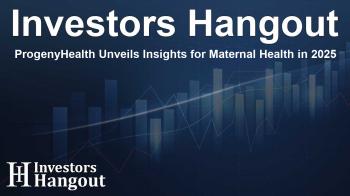ProgenyHealth Unveils Insights for Maternal Health in 2025

ProgenyHealth’s Key Trends for Maternal and Infant Health in 2025
ProgenyHealth, a leader in Maternity and NICU Care Management, recently published a comprehensive report outlining significant trends that will impact maternal and infant health in the near future. This report titled "Steep Challenges & Uneven Progress" explores the critical issues health plans, hospitals, and healthcare providers must address to improve outcomes in maternal and infant care.
The current state of maternal and infant health in the United States reveals unsettling statistics. With the highest mortality rate among wealthy nations, approximately 80% of maternal deaths are preventable, particularly in the crucial weeks following birth. These alarming figures highlight the urgent need for systemic changes in healthcare.
"Despite the considerable challenges, there is a silver lining as healthcare experts actively develop strategies to enhance maternal care," stated Linda Genen, the Chief Medical Officer of ProgenyHealth. She emphasizes the potential of emerging trends to reshape the landscape of maternal and infant healthcare, paving the way for improved outcomes.
Key Trends Identified in the Report
This year’s report outlines several pivotal trends that healthcare providers and policymakers should recognize:
1. Focus on Maternal Decision-Making
Medical institutions are increasingly acknowledging the importance of self-determination during the birthing process. By establishing dedicated care teams to support and listen to mothers during childbirth, hospitals aim to foster a more empowering experience. Research shows that when women feel in control, it can lead to improved health outcomes in the long run.
2. Advancements in Neonatology
Significant advancements in neonatal care have drastically changed the prognosis for micro preemies. Infants born as early as 22 weeks are now thriving, a considerable improvement from previous decades where survival was rare. These innovations are crucial in altering the trajectory of care for the most vulnerable populations.
3. Increased Postpartum Support
Data from the CDC reveals that nearly 30% of pregnancy-related deaths occur in the months following childbirth, often linked to untreated mental health issues. As a response, payers are expected to enhance postpartum support initiatives to better address mental health during this critical period.
4. Employer Demand for Alternative Care Solutions
The rising costs associated with childbirth have prompted employers to seek innovative managed care partnerships. With maternity care being one of the highest expenditure categories in health coverage, organizations will likely advocate for solutions that provide comprehensive support throughout this time.
5. Handling Increased Birth Anomalies
With the anticipated rise in congenital anomalies as birth rates increase nationally, complex care solutions will be necessary. This may involve surgical interventions, ongoing therapy, and educational support for children born with these challenges.
6. Genetic Testing Innovations
Rapid Whole Genome Sequencing (rWGS) offers significant promise for newborns, potentially identifying genetic conditions more swiftly and accurately than traditional tests. While accessibility remains an issue, advancements in this area can have profound implications on early interventions.
7. Rising Popularity of Home Births
As more families opt for home births, some states are exploring policies to ensure safety and support for this choice, which could alleviate some challenges within maternal healthcare.
Susan Torroella, the CEO of ProgenyHealth, stresses the importance of dedication to maternal care. "We are committed to pioneering advancements that will drive significant change in maternal health. Pregnant individuals need assurance that their health is prioritized, and their voices are truly listened to," she remarked.
If you would like to delve deeper into the trends and recommendations laid out in this pivotal report, ProgenyHealth encourages you to explore their knowledge center and resources to advocate for empowering maternal health care.
Frequently Asked Questions
What is the focus of the 2025 ProgenyHealth report?
The report outlines key trends that will influence maternal and infant health in upcoming years, emphasizing the need for systemic changes.
How does ProgenyHealth aim to improve maternal care?
ProgenyHealth focuses on empowering mothers during childbirth and enhancing postpartum support to ensure better health outcomes.
What advancements have been made in neonatal care?
Recent medical advancements are allowing infants born as early as 22 weeks to survive and thrive, significantly improving neonatal outcomes.
How can employers support maternal health initiatives?
Employers can advocate for managed care partnerships and enhance postpartum support to reduce risks associated with childbirth.
What is Rapid Whole Genome Sequencing?
rWGS is a genetic testing method designed to swiftly identify and diagnose various conditions in newborns, improving care strategies.
About Investors Hangout
Investors Hangout is a leading online stock forum for financial discussion and learning, offering a wide range of free tools and resources. It draws in traders of all levels, who exchange market knowledge, investigate trading tactics, and keep an eye on industry developments in real time. Featuring financial articles, stock message boards, quotes, charts, company profiles, and live news updates. Through cooperative learning and a wealth of informational resources, it helps users from novices creating their first portfolios to experts honing their techniques. Join Investors Hangout today: https://investorshangout.com/
Disclaimer: The content of this article is solely for general informational purposes only; it does not represent legal, financial, or investment advice. Investors Hangout does not offer financial advice; the author is not a licensed financial advisor. Consult a qualified advisor before making any financial or investment decisions based on this article. The author's interpretation of publicly available data presented here; as a result, they should not be taken as advice to purchase, sell, or hold any securities mentioned or any other investments. If any of the material offered here is inaccurate, please contact us for corrections.
